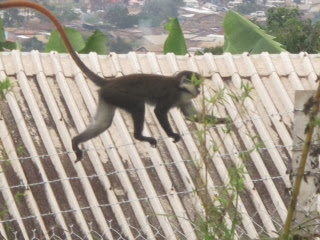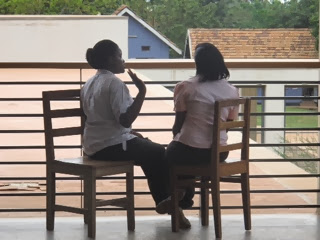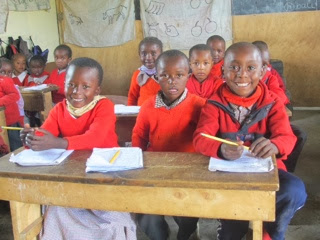Thursday, October 31, 2013
Monkeys All Around
In Boston, when we host our French guests, they are delighted by the squirrels running around Boston Commons. Here there are no squirrels but in the morning and late afternoon, the monkeys put on a show. Like squirrels, they scurry and jump, but their jumping leave the squirrel displays in the dust. They love to swing from tree to tree. They swing out on a hanging branch and swing in a long arc to the next tree. Then three or four of their friends follow. They balance on a fence, keeping upright by sheer speed and the length of their tales. Occasionally they fall but it doesn't seem to matter. Up they go again, chasing and climbing till they tire and find a spot high up to rest.
Wednesday, October 30, 2013
An Awesome Library
We arrived at Uganda Christian University yesterday. I will write more about the school later. But first I want to share our visit to the new library building. The Hamu Mukasa Library is the largest building on campus, and it was designed by Michael Reid, Waring class of '86. 

Michael gave us an architect's tour of the building yesterday afternoon, and we were all blown away by the beauty, ingenuity, and skill of his work.  Because of the cost of running air conditioning for a building this size, Michael designed a climate controlled building, which depends on natural airflow for circulation and climate control. There are louvres to provide light but block the sun's heat. The books are dispersed in modules rather then concentrating them in the same spot. There are open shafts that allow air to move throughout the different floors. Only the room where the servers are stored and the computer lab are air conditioned.
Because of the cost of running air conditioning for a building this size, Michael designed a climate controlled building, which depends on natural airflow for circulation and climate control. There are louvres to provide light but block the sun's heat. The books are dispersed in modules rather then concentrating them in the same spot. There are open shafts that allow air to move throughout the different floors. Only the room where the servers are stored and the computer lab are air conditioned.
 Because of the cost of running air conditioning for a building this size, Michael designed a climate controlled building, which depends on natural airflow for circulation and climate control. There are louvres to provide light but block the sun's heat. The books are dispersed in modules rather then concentrating them in the same spot. There are open shafts that allow air to move throughout the different floors. Only the room where the servers are stored and the computer lab are air conditioned.
Because of the cost of running air conditioning for a building this size, Michael designed a climate controlled building, which depends on natural airflow for circulation and climate control. There are louvres to provide light but block the sun's heat. The books are dispersed in modules rather then concentrating them in the same spot. There are open shafts that allow air to move throughout the different floors. Only the room where the servers are stored and the computer lab are air conditioned.Michael chose building materials which were available in Uganda. The bricks are made with the local red clay. Since steel is not produced in Uganda the structure is concrete and the walls are made of reinforced board form concrete. He used wood planks in the ceilings to damp the sound and provide visual interest. There are also woven bamboo panels on some ceilings to dampen the sound. The books themselves absorb sound.
The library is large and students fill the reading rooms. The study tables are covered with books. The computers are running design software.
Students make good use of computers throuout the building. When I asked them about the library buildings students said they love it. The building came in significantly under budget and on time. The new library opened in 2011 and cost 4.1 million rather than the projected 5 million.
Michael's next project is a new student union building with facilities that encourage the social life of the 8000 students at this campus. He loves it here and looks forward to creating another signature building at UCU. Congratulations to this outstanding Waring alum.
North to the Equator
Yesterday we spent the day in transition. We left the Guest Home in Nairobi at about eleven. We decided that we had better not chance a trip into the city center because the traffic gets worse and worse as the day goes on. Instead we checked our bags early and had a leisurely late lunch at the airport. The flight to Entebbe got us to Lake Victoria just as the sun was setting. Peter had a great view out the window. We looked for Mt. Kilimanjaro but there were many clouds and the airplane's course might not have given us a view anyway. Our hotel in Entebbe was elegant, but we were only there one night. I think we return again at the end of the trip.
Sunday, October 27, 2013
The Birds of Naivasha
The waters and trees are full of several species of cormorant, heron, pelican, duck,ibis, gull, stork, goose, flamingo, in addition to kingfishers, eagles and many others. We donned life jackets and climbed into one of the long narrow motor boats with John, our knowledgable and experienced pilot . 



In addition to birds the lake is full of hippos. During the day these huge animals lounge in the water in family groups. When dusk falls they climb onto land where they graze in the short grass. This is when they are most dangerous because they panic when someone comes between them and the water. 

We were able to walk on this island because the hippos were in the water. Other herbivores such as impala, wildebeest, water buck and zebra roam freely and safely because predators can't reach them. The giraffes were out of sight because the wind was blowing the other way. Giraffes determine wind diection with their horns and prefer to graze with the wind behind them.
Saturday, October 26, 2013
Down Time
Today was down time. Peter finished his conference, and we had lunch at the Hilton before returning to the Classic Guest Home. After an intense week of meetings it was good to sit together on the patio and catch up with each other's doings. It's important to pace yourself when you travel and today gave us some needed rest. The temperature was perfect with a gentle breeze. The patio tables had ample umbrellas, so we just enjoyed being outside in shirtsleeves. We'll see what we feel like doing tomorrow.
There is a Marathon going on tomorrow, which will close roads. It's tempting to see
Kenyan runners in action, but we will probably miss it. Standing in crowds doesn't seem like a wise choice. Kariuki told me that the champion Kenyan marathon runners are from the Kalinjin tribe who live in the Rift Valley. In fact, the teens I saw and photographed on Thursday on top of the Conference Center tower were Kalinjins. I joked with them that if I took their picture now I might see them one day at the Boston Marathon. Turns out that was a good guess. They are tall and slim with light bones. They start training young, sometimes as early as 10. The Rift Valley is also at a high altitude, which increases their endurance. No wonder they win so many Marathons.
Th camera took a rest today. It will come out tomorrow.
Friday, October 25, 2013
Gentle Bells in Longonot
It isn't very often you meet a person who has had a vision, but when you meet a person in the midst of realizing her vision, you feel like you've found something very special. Today I visited the Gentle Bells School in the beautiful Rift Valley. The school was founded by Esther Wawere about 10 years ago in her home. She told me the story in her office, where she welcomed me with a cup of Chai tea.
 This is corn from the school's harvest which will be used for lunches. Some will be ground into meal to make ugali, a type of polenta.
This is corn from the school's harvest which will be used for lunches. Some will be ground into meal to make ugali, a type of polenta. Esther wants the school to be a beautiful place. She makes sure the plants are trimmed and watered in the front of the building.
Esther wants the school to be a beautiful place. She makes sure the plants are trimmed and watered in the front of the building. The school faces Mount Longonot, which is a volcano, although it has been many years since the last eruption.
The school faces Mount Longonot, which is a volcano, although it has been many years since the last eruption.
The year before she married, she had a vision. She assured me that she was sitting on her bed, but she was not asleep. She saw a school with a blue roof facing the beautiful Longonot Mountain. When she discussed it with her future husband he wasn't convinced that there was anything to the vision, but Esther dreamed of starting such a school.
After she got married she worked in a local public school. But after her first son was born, she decided to pursue her dream. She started with three children around her kitchen table. Esther is a person of strong Christian faith and she prayed persistently that her dream be realized. The school began to grow, and they found a space in the town. But Esther did not forget her vision. In 2009 she made contact with friends of mine, David and Nancy Mering of Essex. Although she had no money, the Merings encouraged her to look for land on which to build the school. When she found the land they and others raised the money to purchase the land and build a spacious and attractive building, facing the beautiful Longonot Mountain, just as in her vision, although the roof is not blue. They moved in January of 2011 and are just completing their third year in this new structure.
The classes range from preschool to 7th grade. Students come from the surrounding area always on foot. A car is a rare occurrence at Gentle Bells. They walk from as far away as 7 kilometers, leaving home at 6:30 or 7 and leaving school in the afternoon at 4:30 for the long walk home. They carry backpacks heavy with books and large water bottles. They have to do their homework without assistance from their parents because most are illiterate farmers. The children are bright and enthusiastic, and love school. School is a happy place, and the children's voices are the bells. Hungry children are poor learners so Esther has arranged for a meal of porridge in the morning and a hot lunch cooked in the temporary kitchen.
Here in the country about an hour's drive from Nairobi I have found another school with an exceptional leader, working to bring education to children who live in very difficult circumstances. I am struck by how much these children value learning, and how much education means to them. I am also amazed by the joy of learning which transcends so much hardship. Now Esther dreams of a time 20 years from now when these children will be educated adults making a difference in Kenya and the world.
The great Rift Valley
Esther has both a vision and a strong vision statement.
 This is corn from the school's harvest which will be used for lunches. Some will be ground into meal to make ugali, a type of polenta.
This is corn from the school's harvest which will be used for lunches. Some will be ground into meal to make ugali, a type of polenta.This is a huge pot of beans and corn cooking on a wood fire in the kitchen outbuilding. Esther hopes eventually to build a permanent kitchen.
During the rains the water drains off the large school roof to fill this cistern and provide water.
 Esther wants the school to be a beautiful place. She makes sure the plants are trimmed and watered in the front of the building.
Esther wants the school to be a beautiful place. She makes sure the plants are trimmed and watered in the front of the building. The school faces Mount Longonot, which is a volcano, although it has been many years since the last eruption.
The school faces Mount Longonot, which is a volcano, although it has been many years since the last eruption.
Thursday, October 24, 2013
Kissing a Giraffe and other doings
The convention center is very patriotic with flags and a statue of Jomo Kenyatta, the father of Kenya.
Looking toward the Ngong Hills from the top of the Convention Center.
Allegra can't resist a school group on a trip. They are from a public high school and are visiting Nairobi for 2 days.
Marvelous jacaranda at the Railway Museum.Nairobi owes it's existence to the engineering difficulties the British encountered as they tried to build the track over the eastern escarpment of the Rift Velley. Finally they completed the track from Mombasa on the coast to Kisimu on Lake Victoria in 1901.
At the Giraffe Center in the southern suburb of Karen, giraffes ate from our hands. Their tongues are vey long and thin (25cm). They greedily pick up food pellets from your hand. After a few pellets when thy are used to you they will grab the pellet from between your lips planting a wet kiss on your face.Just before the kiss.
What beautiful, graceful and friendly animals they are.
Peter's conference had a gala dinner at Carnivore, the best restaurant in Nairobi. We were entertained before dinner with Masai dancers, Chukha dancers and different groups of drummers. I made friends with the Congolese woman at our table when I asked, "Parlez-vous français?" Once we started, we never stopped talking.
Subscribe to:
Posts (Atom)












































